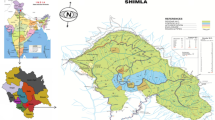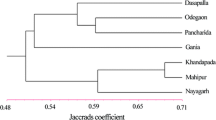Abstract
Five indices of species richness, species diversity and species evenness were used to assess α diversity of four types of coniferous forests undergone different artificial regeneration time. The study was based on the vertical structure of forests, involving growth-forms of total plants as well as vertical layers of woody plants. The results showed that, except for the fourth layer of woody plants, the vertical structure of the four forests exhibited significant difference in terms of their species richness, species diversity and species evenness, suggesting that α species diversity index provided more detailed information and was a better index reflecting the regeneration processes in this region It was recommended that silvicultural management of artificially regenerated forests should be strengthened to conserve the biodiversity of the forests, optimize forest structure and, in the long run, promote sustainable development of forest ecosystems.
Similar content being viewed by others
References
Li Chengbiao.Ecological Study of Sichuan Forest [M]. Chengdu: Sichuan Science and Technology Press, 1990:3–48 (Ch).
Yang Yupo, Li Chengbiao, Guan Zhongtian,et al. Forests in Sichuan [M]. Beijing: China Forestry Publishing House, 1992: 193–362 (Ch).
Xiang Chenghua, Yang Yupo. Distribution Characteristics and Succession Regulation of the Forests in Alpine and Canyon Region of western Sichuan Province, P. R. China [J].Journal of Forestry Research, 2002,13(4):327–330 (Ch).
Liu Qing.Ecological Research on Subalpine Coniferous Forests in China [M]. Chengdu: Sichuan University Press, 2002:102–103 (Ch).
Lindgren P M, Sullivan T P. Influence of Alternative Vegetation Management Treatments on Conifer Plantation Attributes: Abundance, Species Diversity and Structural Diversity [J].Forest Ecology and Management, 2001,142:163–182.
Roberts M R, Gilliam F S. Patterns and Mechanisms of Plant Diversity in Forested Ecosystems: Implications for Forest Management [J].Ecological Applications, 1995,5: 969–977.
Onaindia M, Dominguez I, Albizu I,et al. Vegetation Diversity and Vertical Structure as Indicators of Forest Disturbance [J].Forest Ecology and Management, 2004,195:341–354.
Koop H.Forest Dynamics. Silvi-star: A Comprehensive Monitoring System [M]. Berlin: Springer Verlag, 1989.
Ruiz-Jae'n M C, Aide T M. Vegetation Structure, Species Diversity, and Ecosystem Processes as Measures of Restoration Success [J].Forest Ecology and Management, 2005,218:159–173
Magurran A E.Ecological Diversity and Its Measurement [M]. Princeton: Princeton University Press, 1988.
Margalef R. Information Theory in Ecology [J].General Systems, 1958,3:36–71.
Shannon C E. The Mathematical Theory of Communication [M]//Shannon C E, Weaver W.The Mathematical Theory of Communication. Urbana: University of Illinois Press, 1949:29–125.
Simpson E H. Measurement of Diversity [J].Nature, 1949,163:688.
Pielou E C.Ecological Diversity [M]. New York: John Wiley & Sons Inc, 1975.
Sokai R R, Rohlf F J.Biometry [M]. New York: WH Freeman and Company, 1981.
Joseph H, James L K, Joseph T N. Forest Structure Characteristics in Disturbed and Undisturbed Sites of Mt. Elgon Moist Lower Montane Forest, Western Kenya [J].Forest Ecology and Management, 2004,194:269–291.
Brosofske K D, Chen J, Crow T R. Understory Vegetation and Site Factors: Implications for a Managed Wisconsin Landscape [J].Forest Ecology and Management, 2001,146:75–87.
Yin Huajun, Liu Qing. Soil Seed Bank of Constructive Species Picea asperata of Subalpine Coniferous Forest in Western Sichuan, China [J].Chinese Journal of Applied Environment Biology, 2004,10(5):581–584 (Ch).
Tilman D. The Ecological Consequences of Changes in Biodiversity: A Search for General Principles [J].Ecology, 1999,80: 1455–1474.
Aubert M, Alard D, Bureau F.Diversity of Plant Assemblages in Managed Temperate Forests: A Case Study in Normandy (France) [M]. Forest Ecology and Management, 2003,175:321–337.
Author information
Authors and Affiliations
Corresponding author
Additional information
Foundation item: Supported by the National Natural Science Foundation of China (90511008), the Knowlege Innovation Program of Chinese Academy of Sciences (KZC2-SW-123-5), Key Project of Chinese Academy of Sciences Knowledge Innovation Program, International Cooperation Program of Academy of Finland (WAMEC) and the Sichuan Science and Technology Foundation for Youth (03ZQ026-043).
Biography: ZHANG Qiaoying (1976-), female, Ph. D. candidate, research direction: plant ecology and alpine ecology.
Rights and permissions
About this article
Cite this article
Qiaoying, Z., Yunchun, Z., Yirdaw, E. et al. Species diversity based on vertical structure as indicators of artificial restoration for coniferous forests in Southwest China. Wuhan Univ. J. Nat. Sci. 11, 1003–1008 (2006). https://doi.org/10.1007/BF02830201
Received:
Issue Date:
DOI: https://doi.org/10.1007/BF02830201




